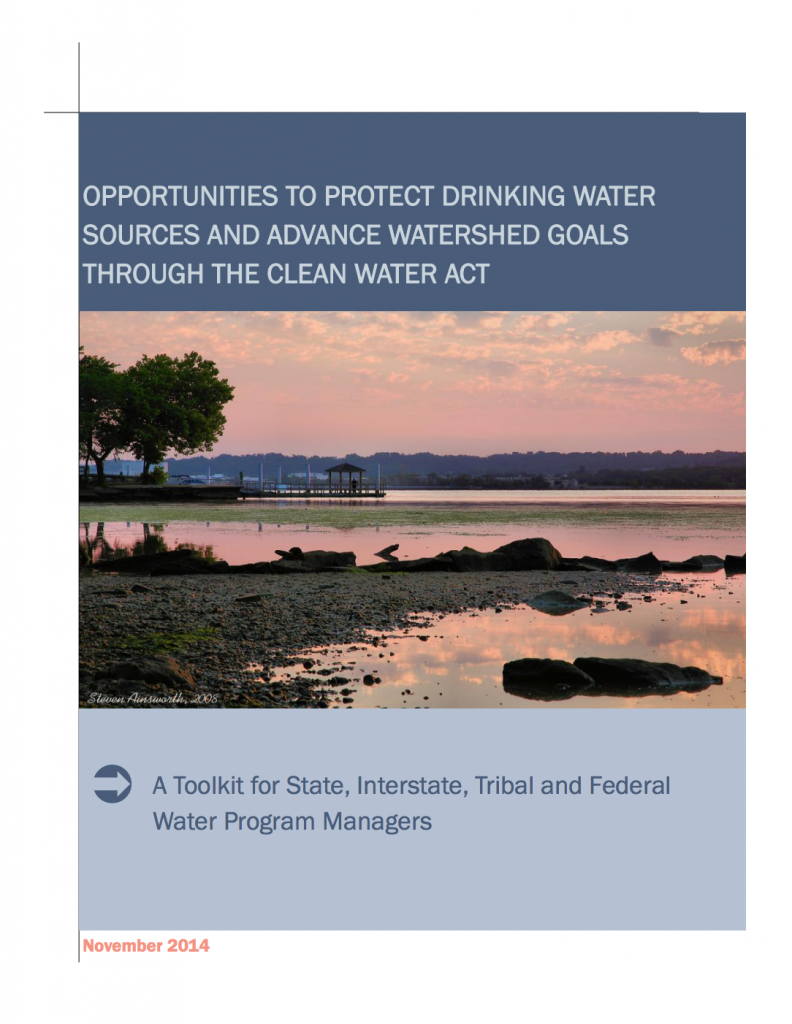The goal of this State-EPA collaboration initiative is to show how state and federal Clean Water Act (CWA) and Safe Drinking Water Act (SDWA) program staff and managers can more routinely and more intentionally coordinate CWA and SDWA activities to achieve improvements in the quality of our waters.
This Toolkit:
- identifies opportunities to reduce pollution in drinking water sources by using CWA tools;
- provides examples of on-the-ground implementation, and is intended to help readers understand how they can work across program lines and agency boundaries;
- demonstrates how program managers can align their efforts to protect source water through a combination of
actions and institutional relationships that facilitate cross-program coordination at the national, regional, state, and watershed scales to achieve common objectives; and - shows how state clean water programs can leverage the high value consumers place on public health protection and safe drinking water to increase public support for addressing surface and ground water quality challenges more effectively.
EPA, other federal and state agencies, local governments and private organizations6can support such collaborative actions by providing technical, programmatic, financial and logistical assistance.
Following the Executive Summary, this document consists of an Introduction that describes the basics of the SDWA and CWA and how they interact, including a “Quick Start to Coordination” section that offers some actions that states and EPA regions can take more readily, likely with existing staff and resources. Following the Introduction, each section of the Toolkit pertains to how specific CWA provisions and tools can be used to protect drinking water resources. The five sections focus on, respectively, Water Quality Standards (WQS); Monitoring, Assessment, and Impaired Waters Listings; Total Maximum Daily Loads (TMDLs); the National Pollutant Discharge Elimination System (NPDES); and Nonpoint Source and Clean Water Act 319 programs. Sections describe a range of potential state activities that could enhance public health protection under each of these provisions, as outlined in a format that includes:
- Background information on the provision or tool of the CWA;
- The desired outcomes of possible activities using that CWA provision;
- A list of key actions that could move CWA implementation toward achieving the desired outcome;
- A short list of additional references and resources.
Finally, the appendices provide additional resources. These include examples of states already implementing many of the opportunities described in this document, as well as challenges faced and strategies for overcoming such challenges.
Each state’s water quality challenges, approaches to addressing these challenges, and program organization and implementation are unique. The measures outlined in this document can be used together, and in collaboration with partners outside of the state and federal water programs, to achieve both operational efficiencies and water quality improvements. Clean water and drinking water program staff, state infrastructure financing staff, enforcement staff, water and wastewater utilities, technical assistance providers, and other partners could work together to look holistically at the pollutant sources and controls in a particular watershed and aquifer recharge zone. This coordination could include an assessment of drinking water, wastewater, stormwater, and nonpoint source concerns and needs to help partners develop creative and appropriate source water protection solutions.


